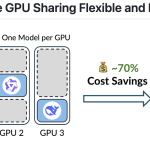Meet ‘kvcached’: A Machine Learning Library to Enable Virtualized, Elastic KV Cache for LLM Serving on Shared GPUs
PositiveArtificial Intelligence

The introduction of 'kvcached' marks a significant advancement in machine learning, particularly for large language model (LLM) serving. This innovative library allows for a virtualized and elastic key-value cache, optimizing GPU memory usage by adapting to varying request loads. Developed by researchers at Berkeley's Sky Computing Lab, 'kvcached' addresses the common issue of wasted GPU resources, making it a game-changer for developers and researchers who rely on shared GPUs. This development not only enhances efficiency but also paves the way for more sustainable AI practices.
— Curated by the World Pulse Now AI Editorial System


